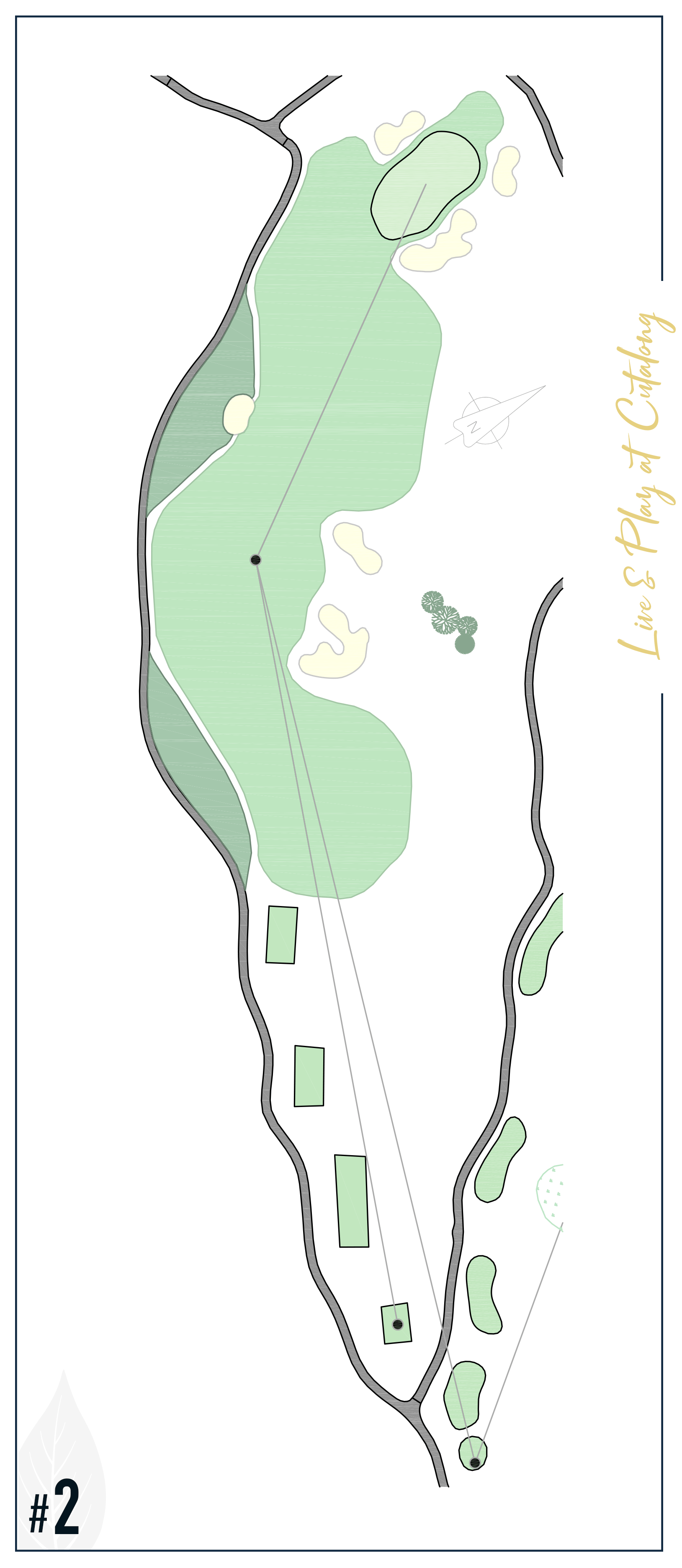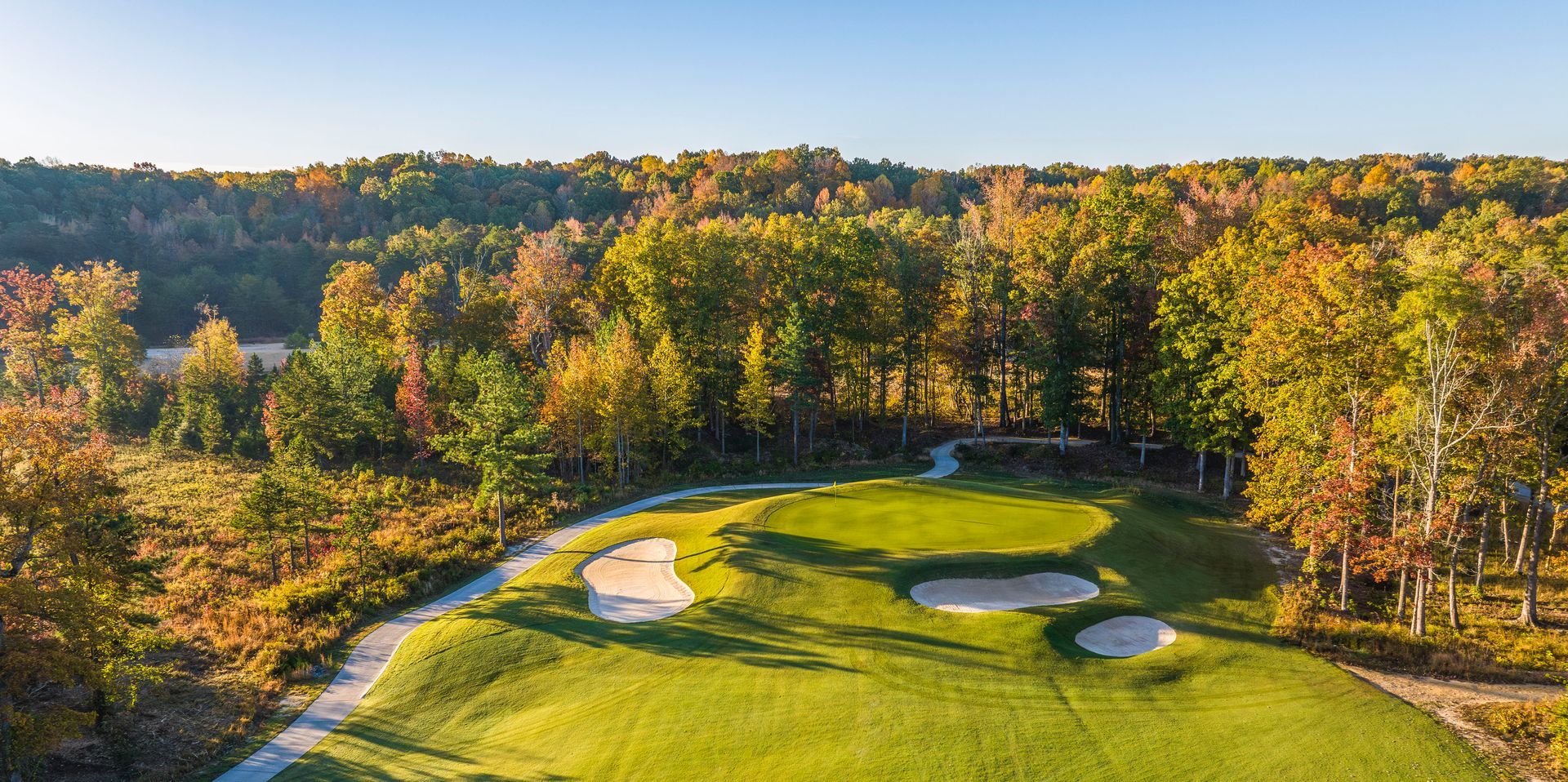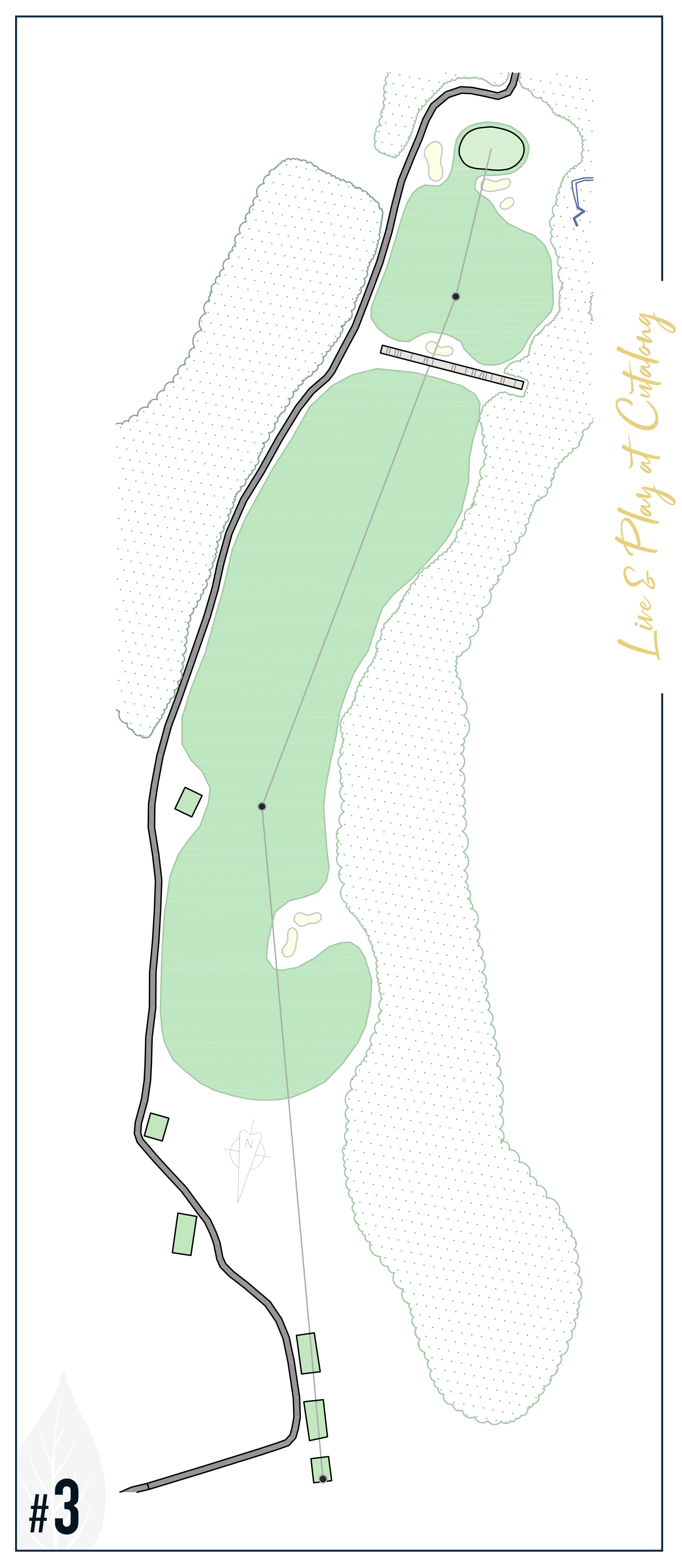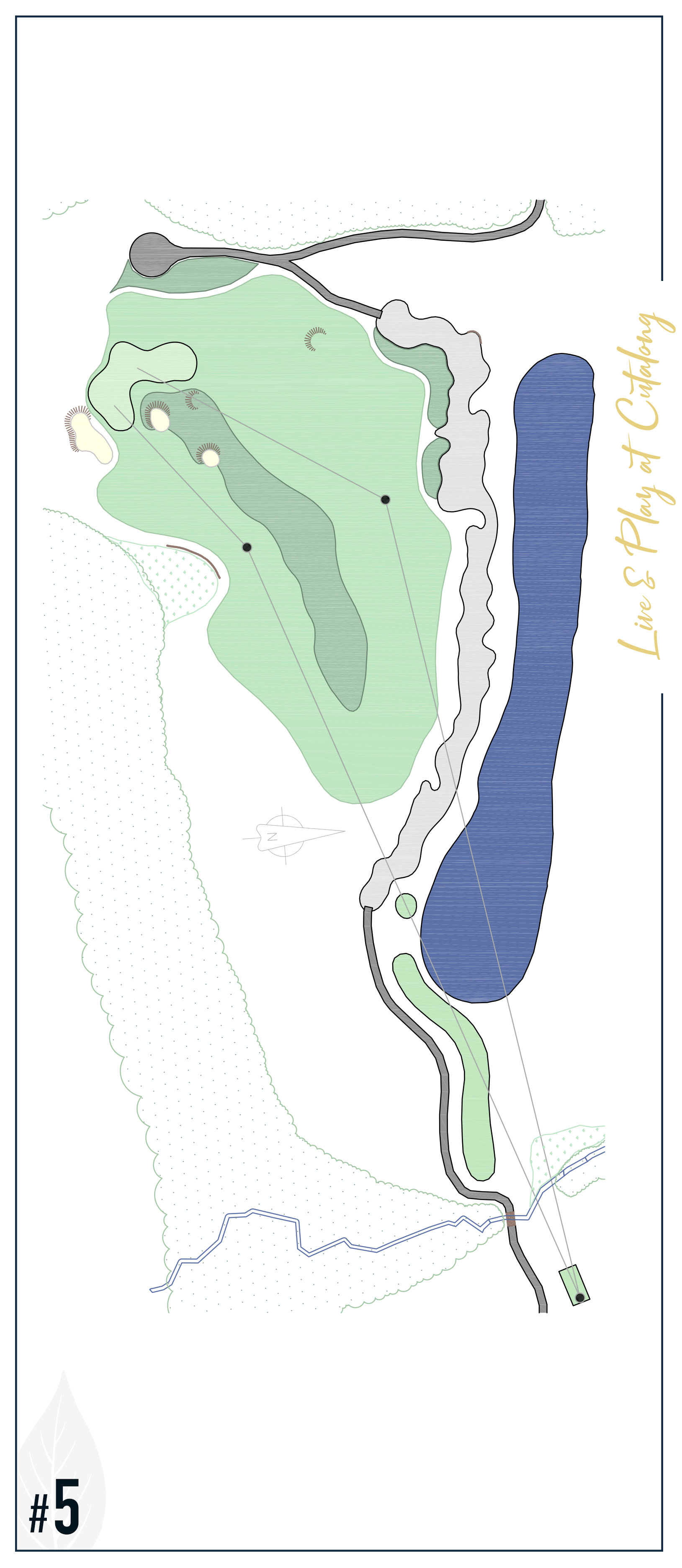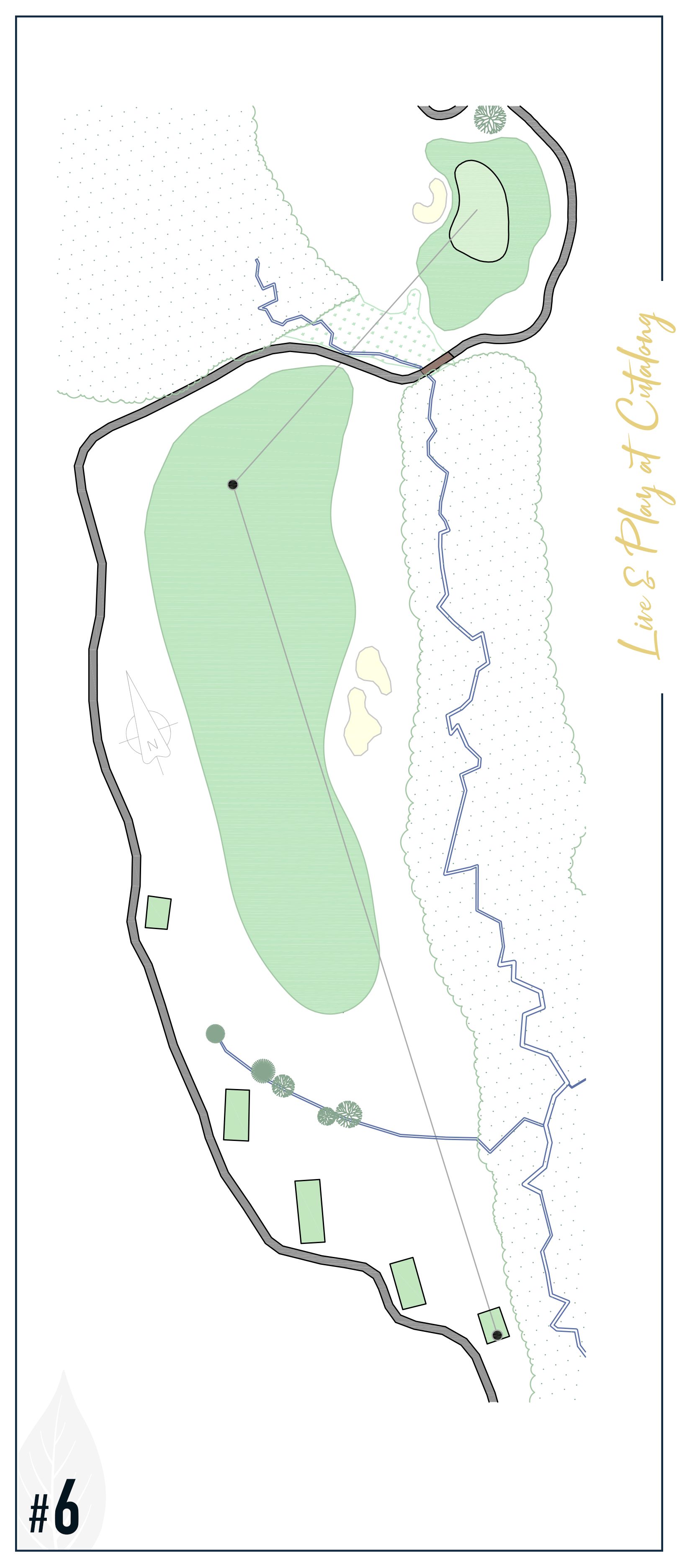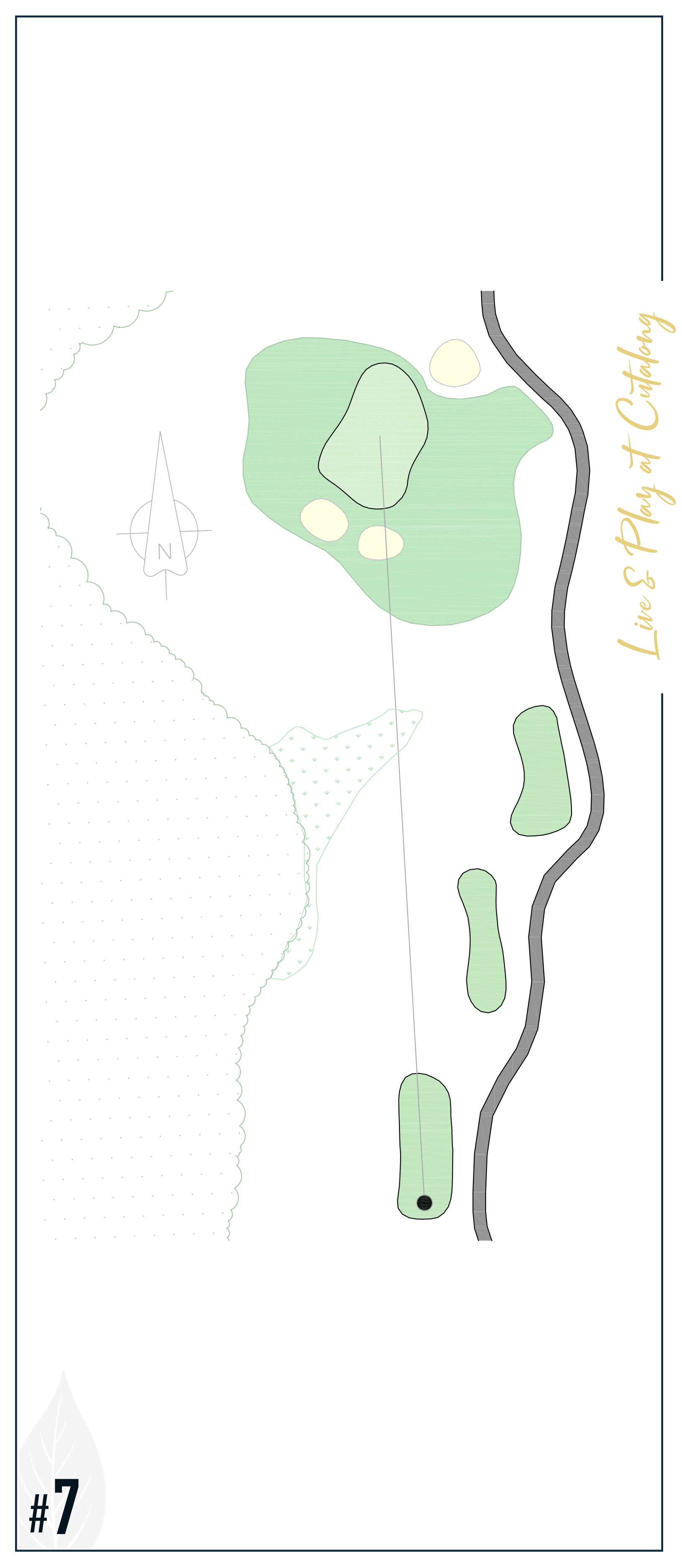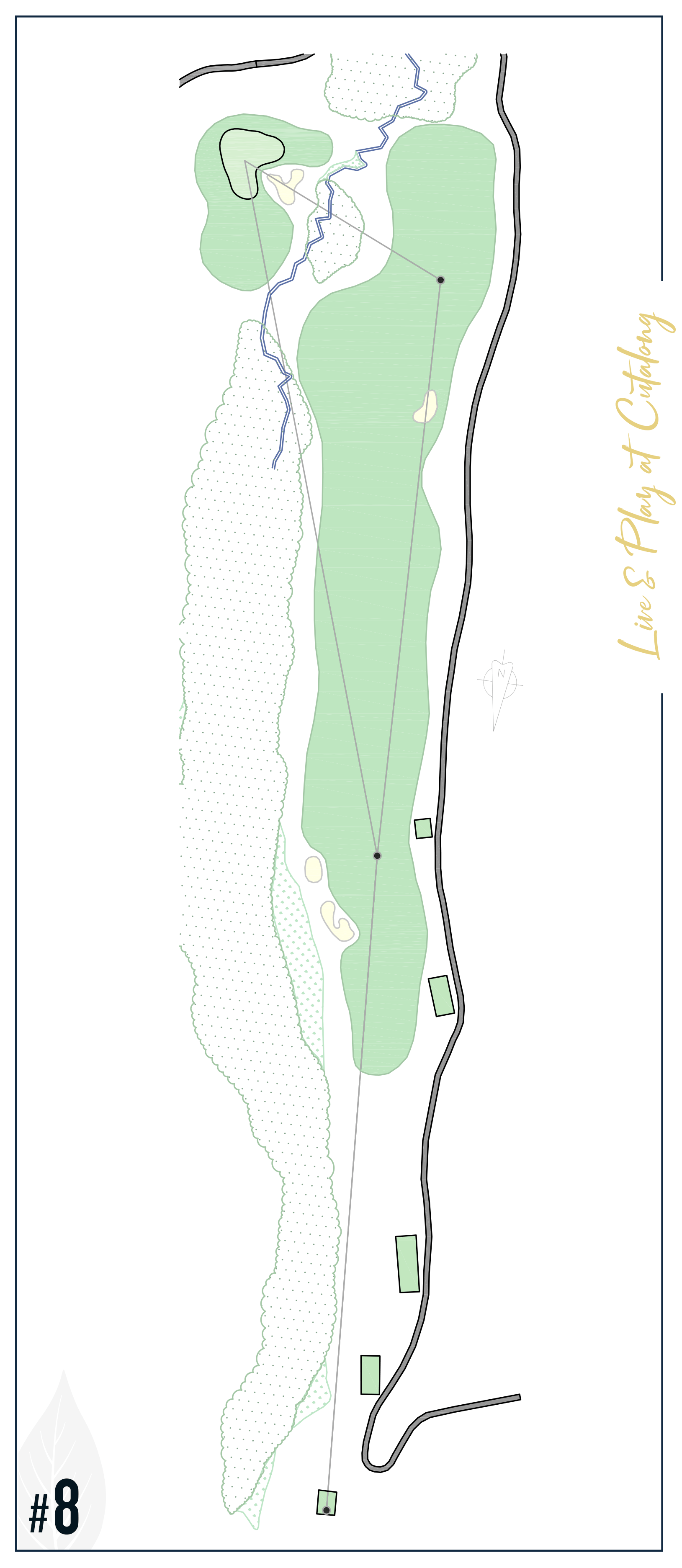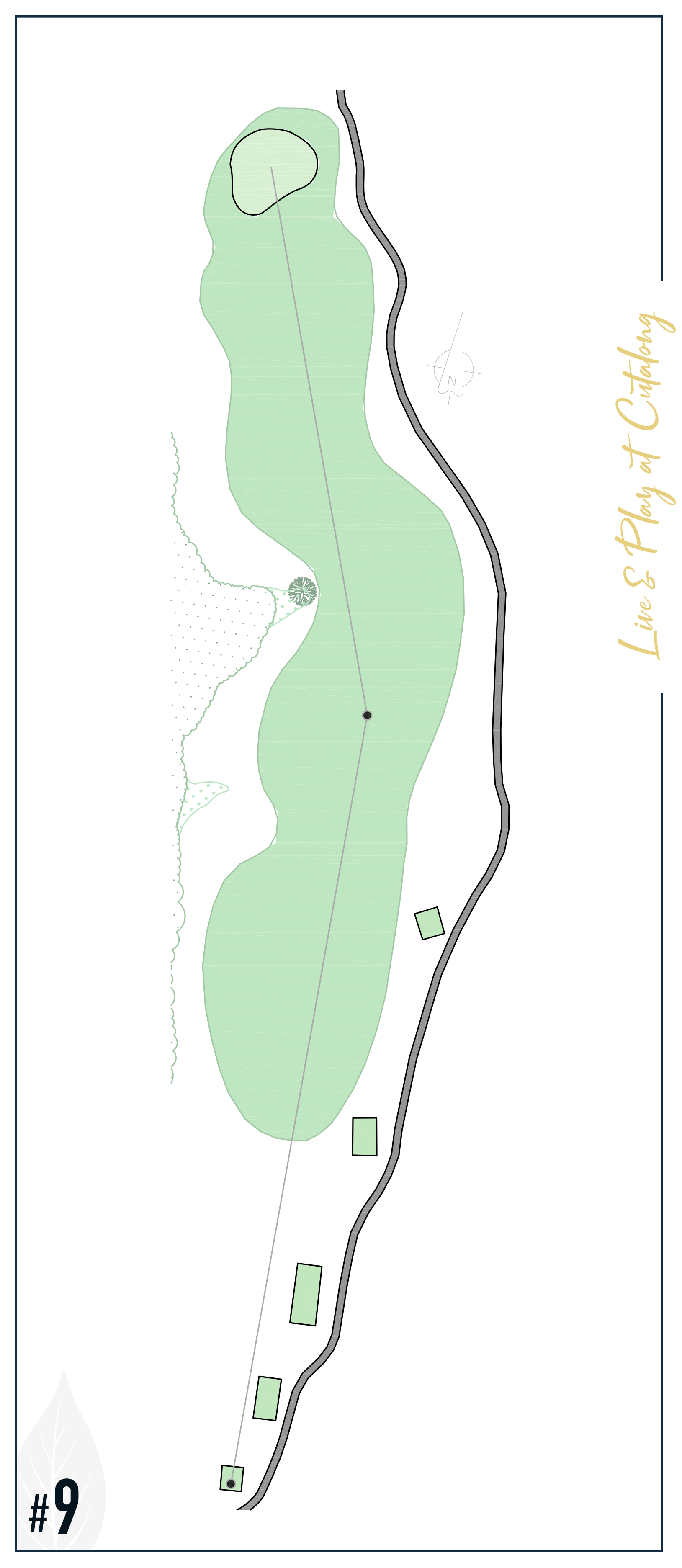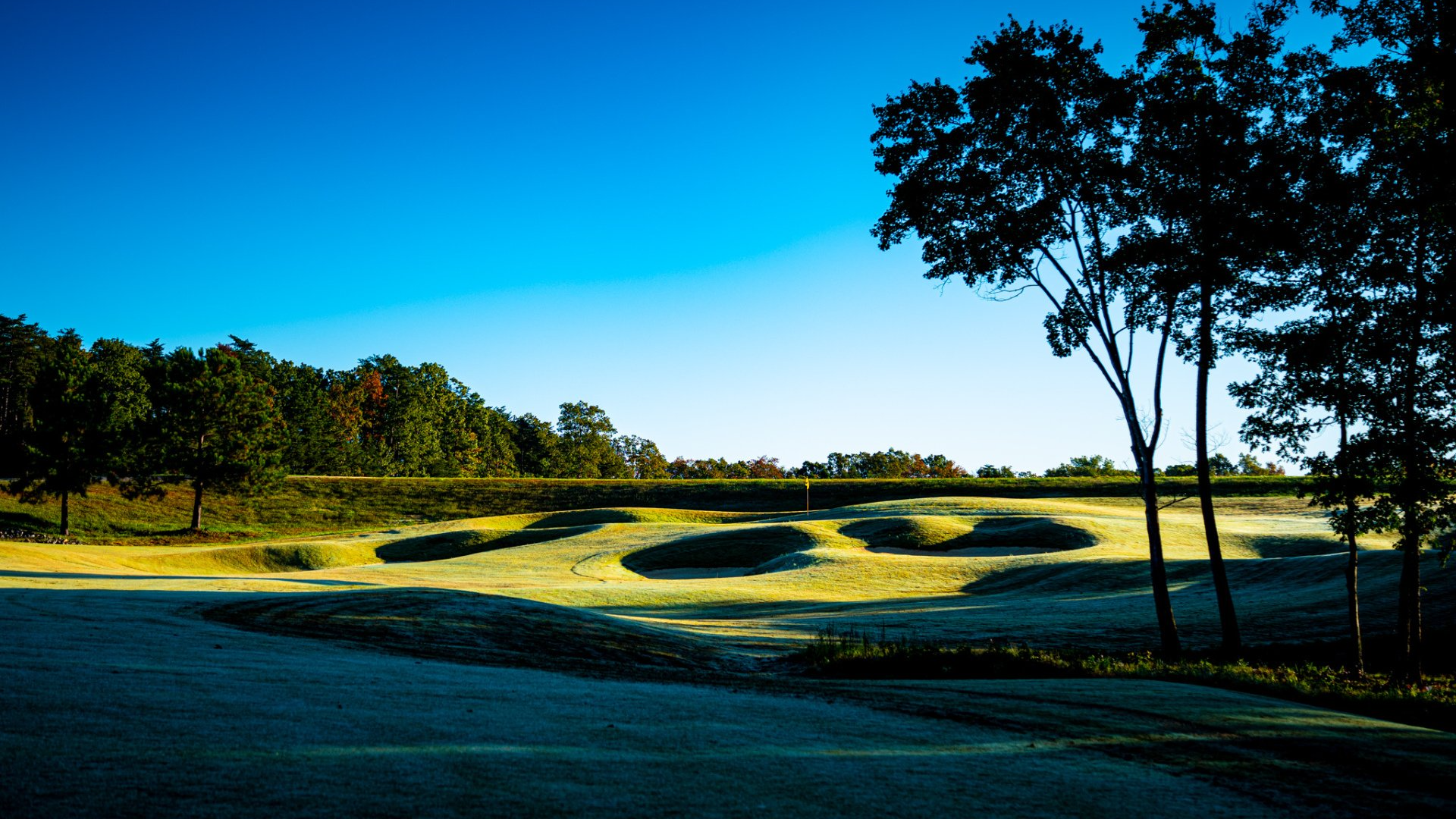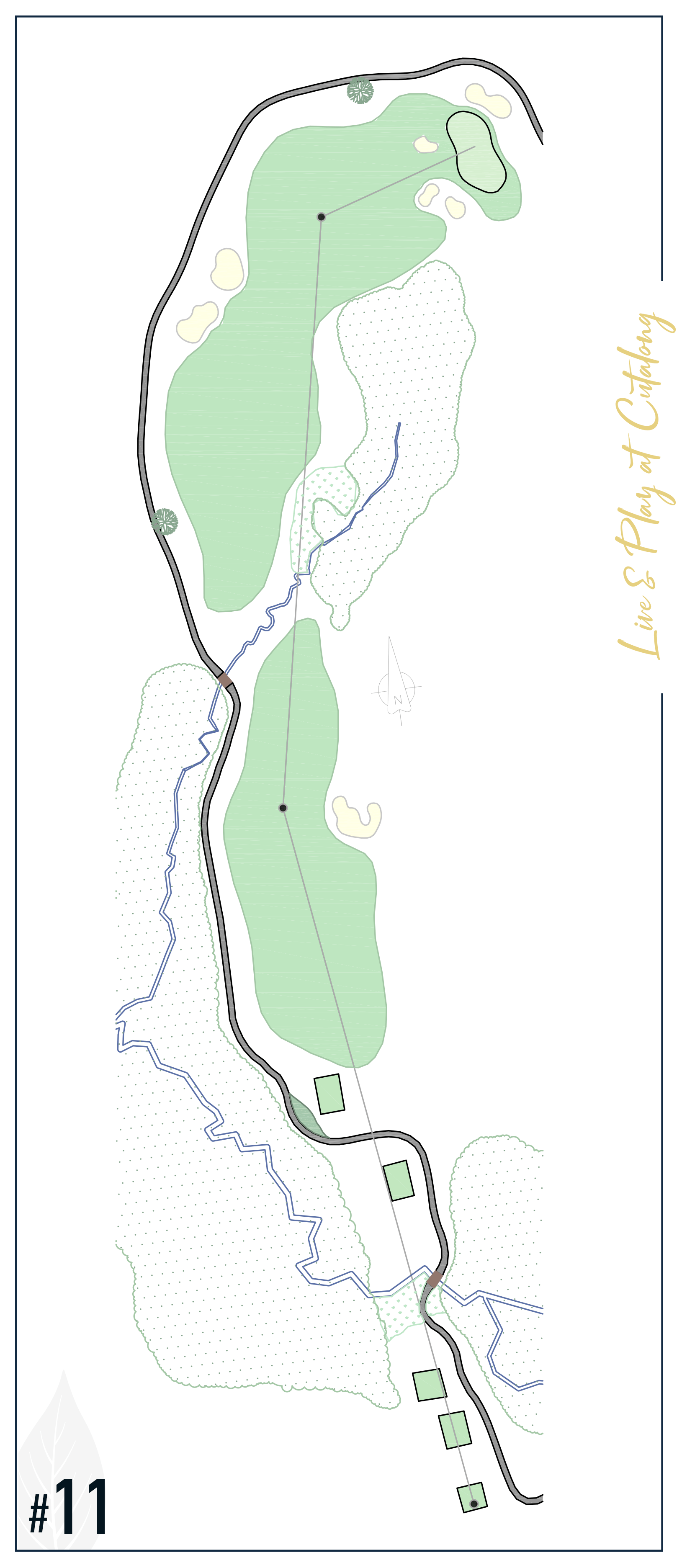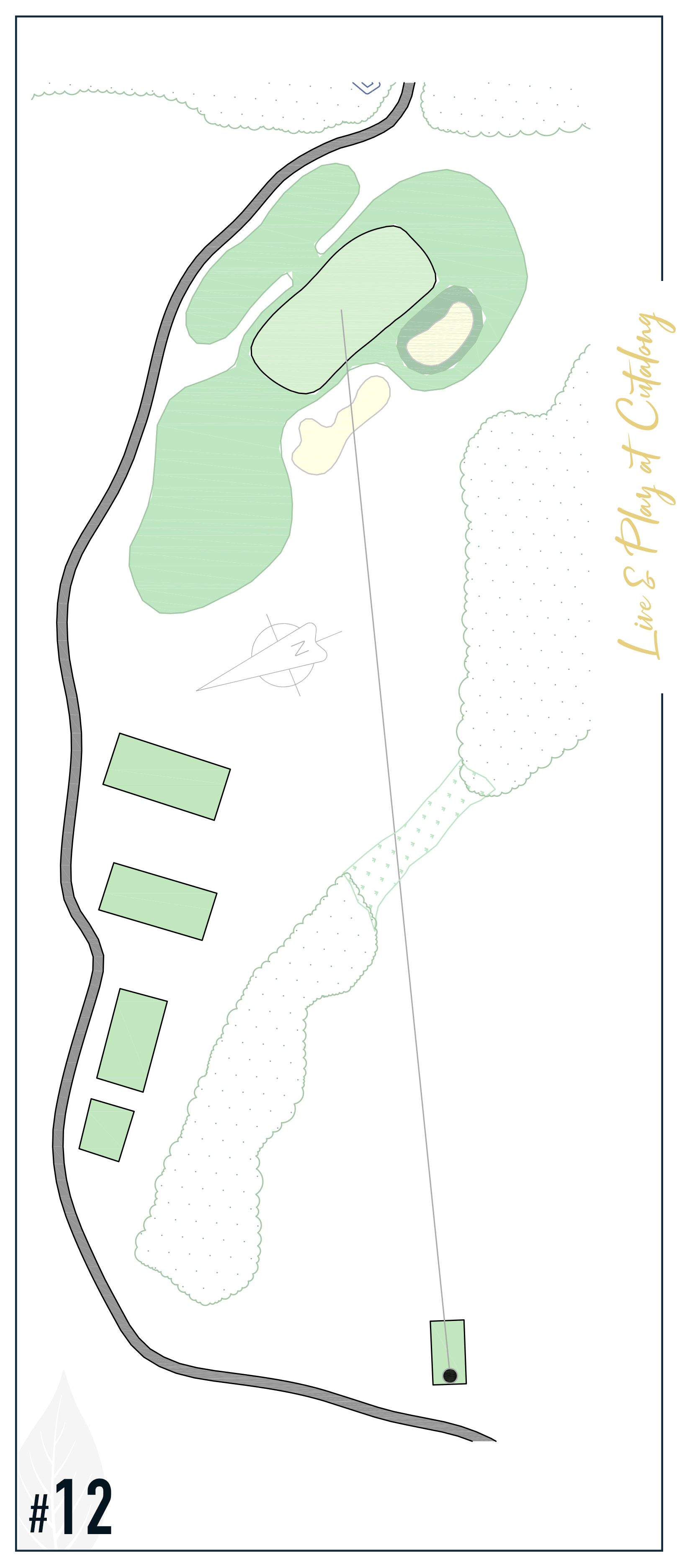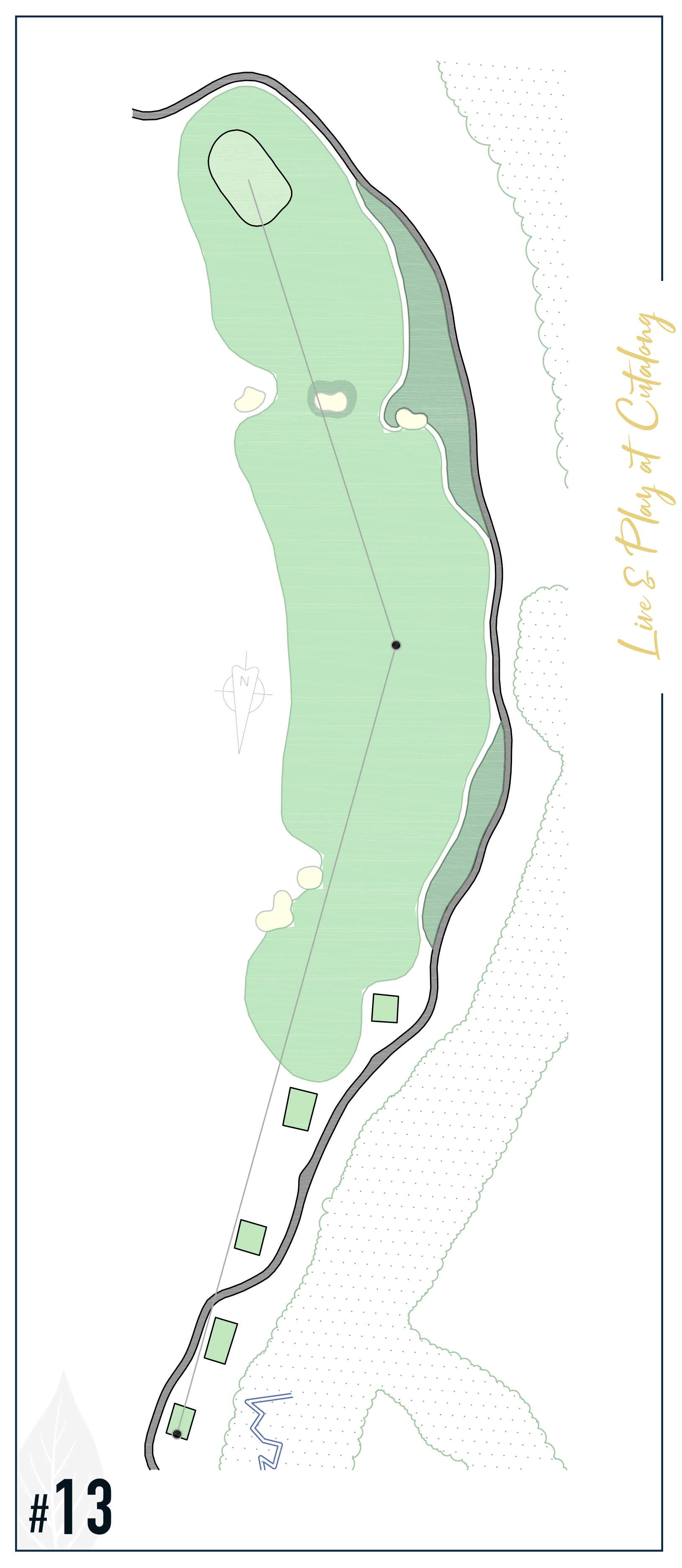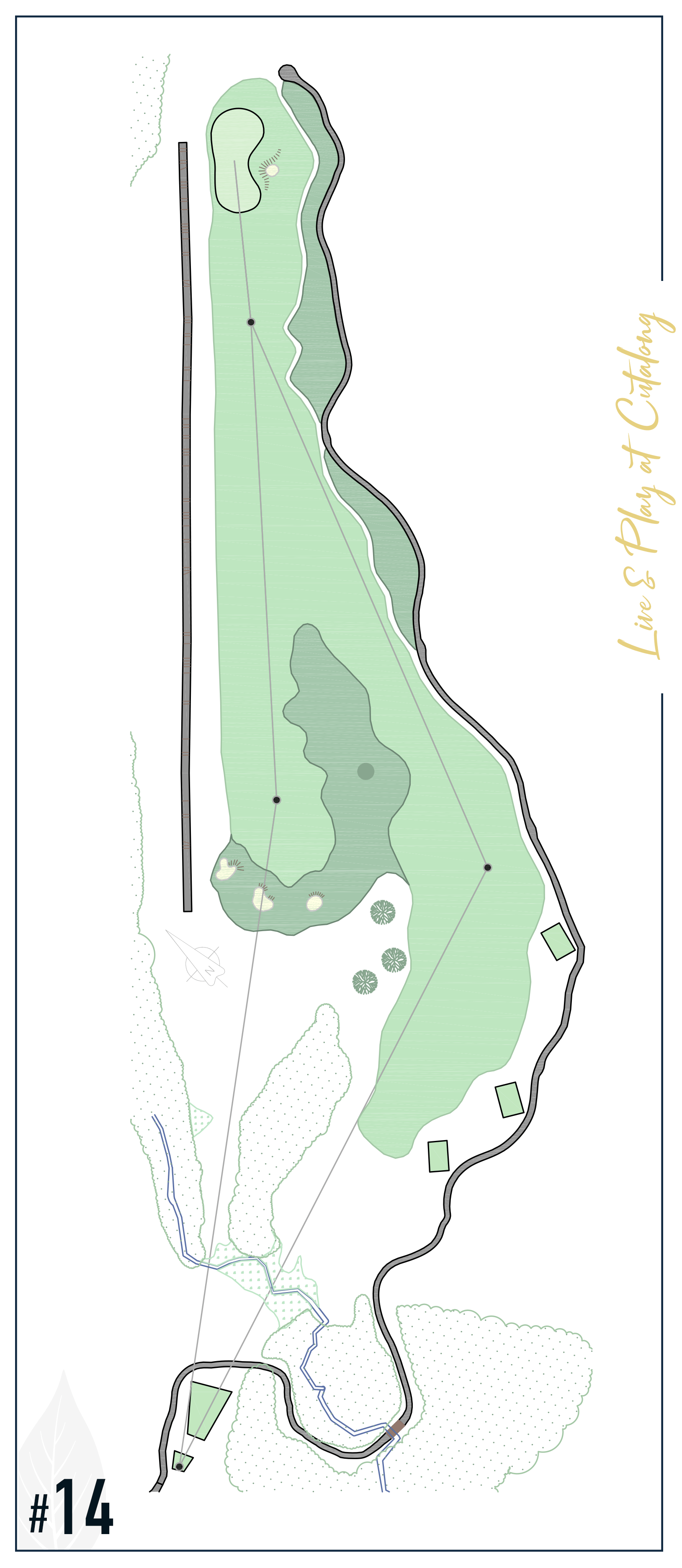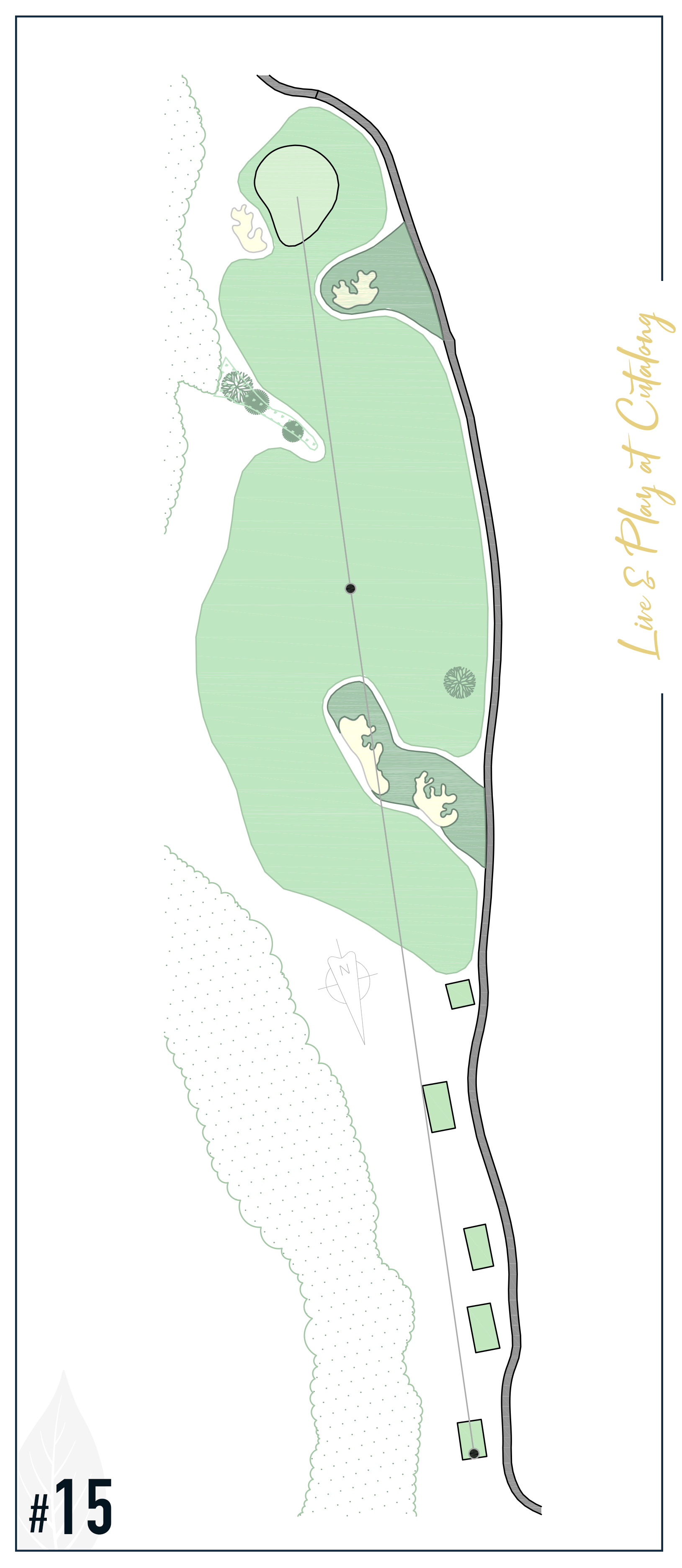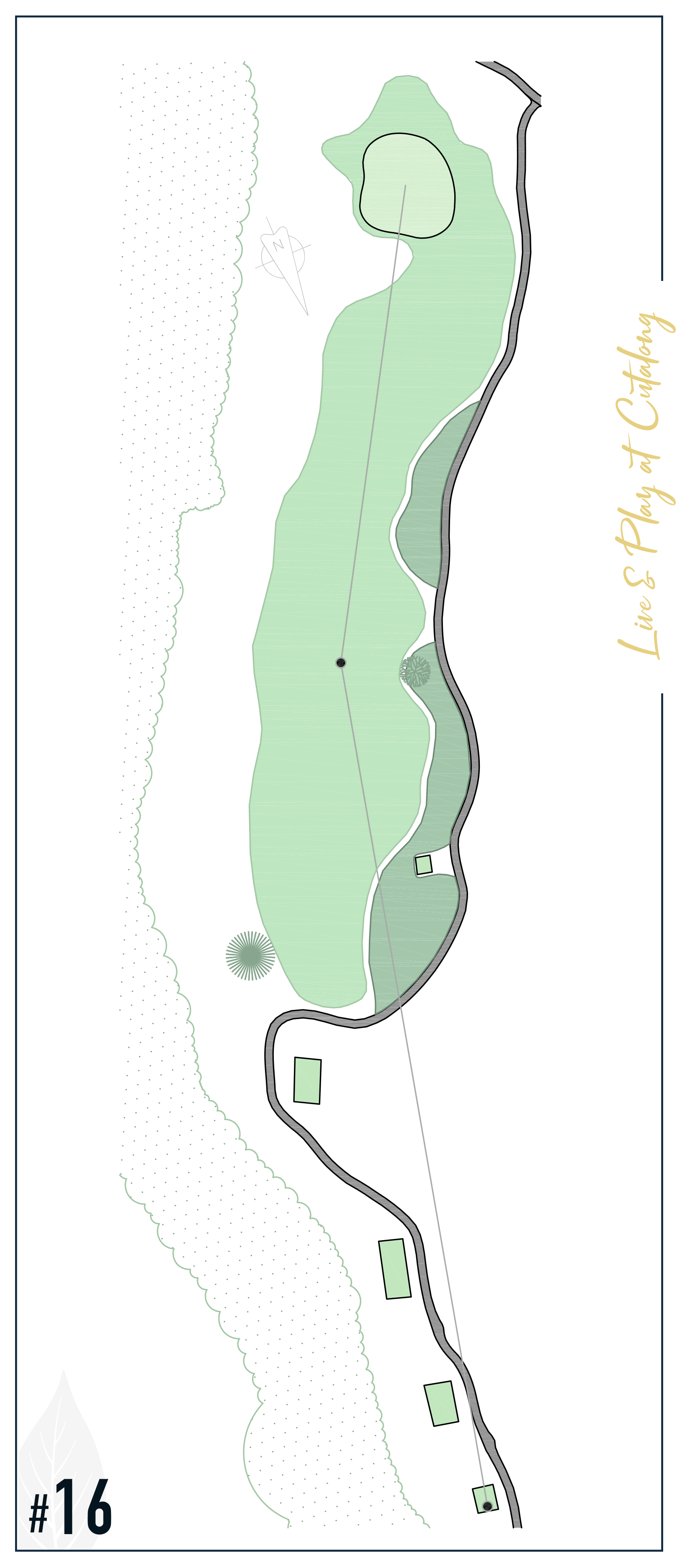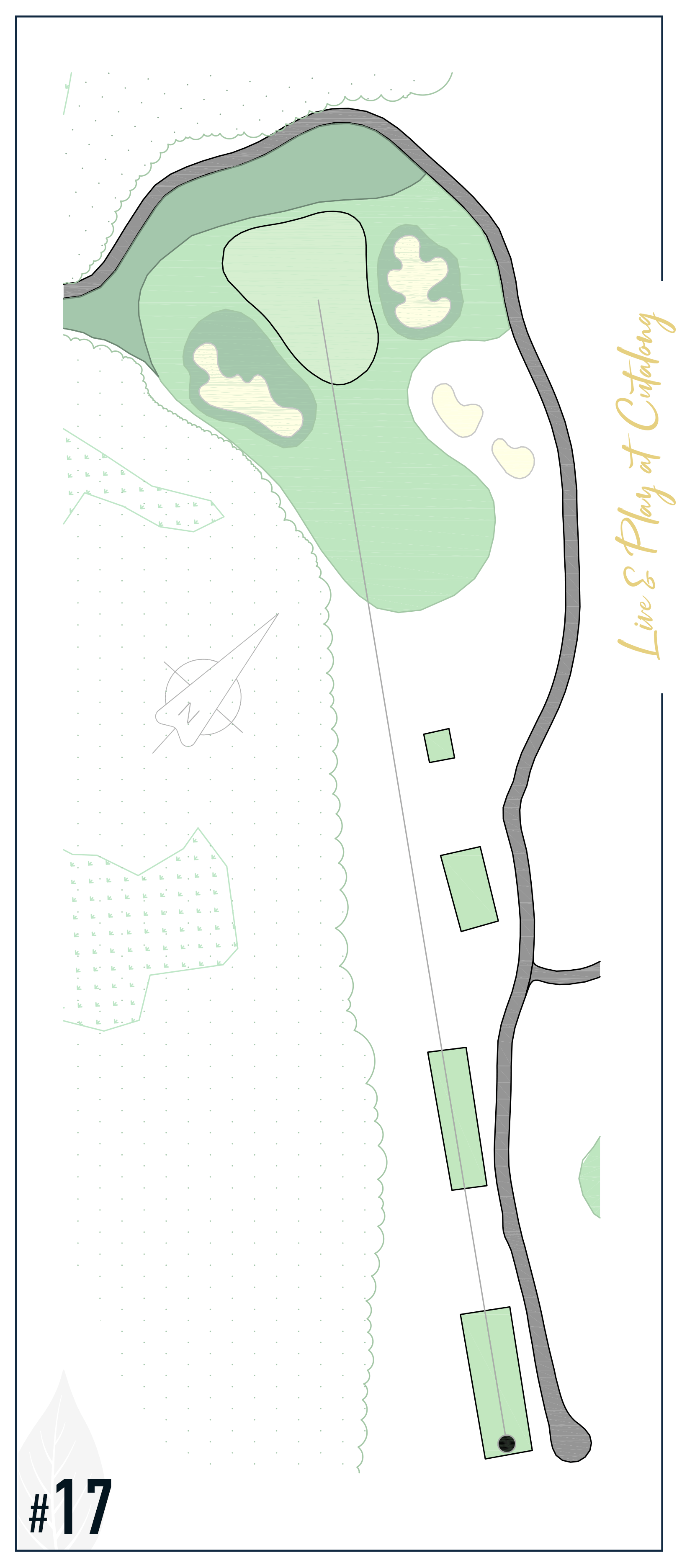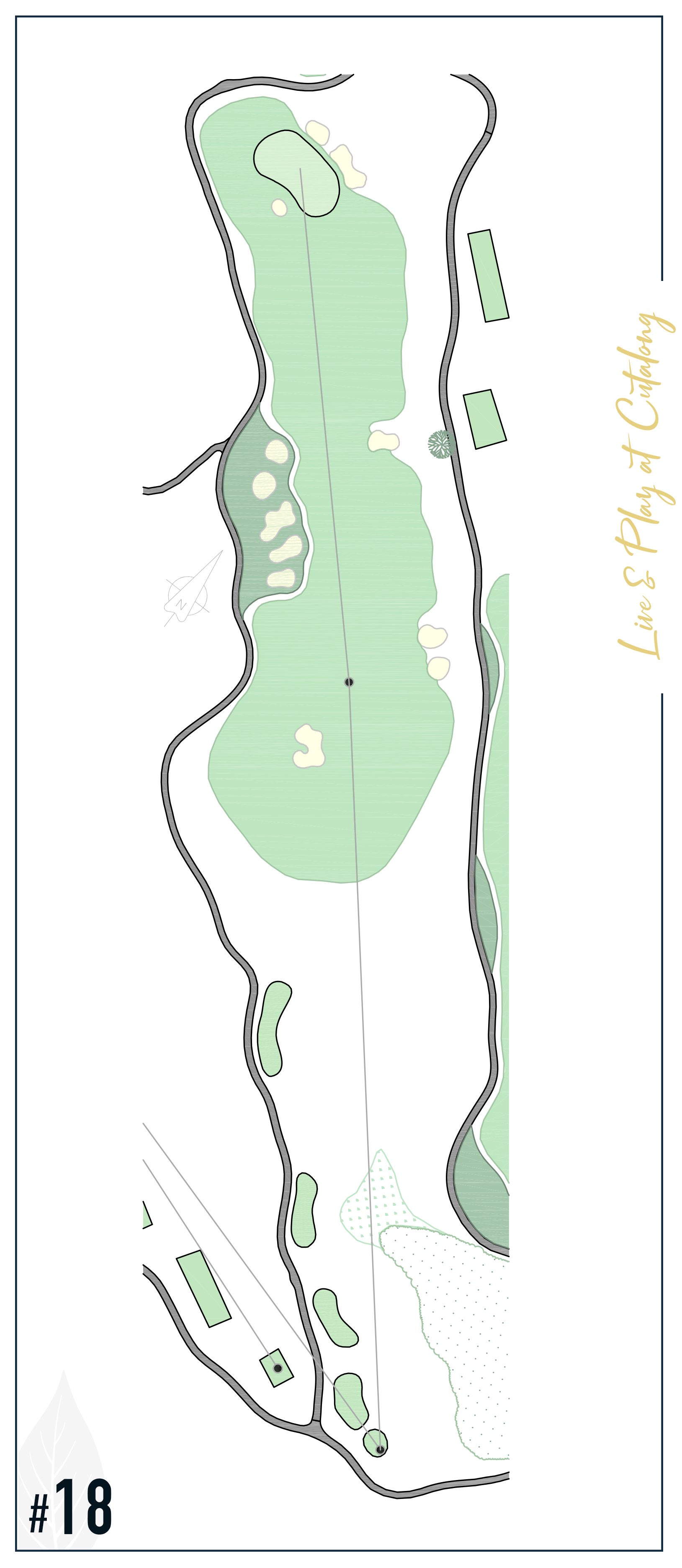THE COURSE
THE COURSE
Cutalong is a true concept course created as a 21st century National Golf Links, patterned after Charles Blair MacDonald's original, which cherry-picks features from famous golf holes throughout the U.K. and focuses on finding old British and American golf features that best fit our property. We have incorporated a Civil War theme to honor its 150th anniversary. By enlisting Ron Whitten as a consultant, longtime senior architecture editor of Golf Digest, and expert on the history of old and new courses and civil war the final piece to the puzzle has been completed. Discover the inspiration of each hole at Cutalong below.
A novel private golf course.
Using the method established by pioneer golf architect C.B. MacDonald at National Golf Links of America in the early 1900s, veteran golf architect Tom Clark has selected special features from famous British and American golf holes to produce the beautiful and distinctive Cutalong golf course on the highlands above Lake Anna, Virginia. To serve as a consultant, Clark enlisted Ron Whitten, the longtime senior editor on architecture for Golf Digest, and together they’ve worked and reworked the design since its inception back in 2000. The passage of time has made the completion of this golf project especially satisfying.
From the beginning, Clark envisioned a novel golf course that would be less expensive to build and maintain, would use less water and chemicals, would be challenging yet enjoyable and possess an unforgettable sequence of holes. As Lake Anna is near several Civil War battlefields, aspects of some holes are based by 19th Century fortresses and defenses. Because Cutalong rests atop a defunct mining operation, certain holes reflect that heritage as well.
Hole NO.1
The lay-of-the-land nature of Cutalong’s design is evident on the first hole, with a domed hill nearly a hundred yards wide serving as the fairway. A lone tall cedar in the center just past the crest forces players to pick an angle off the tee. The smart play is up the left side as that sets up the best axis into the long, slender green, one inspired by the fourth at Robert Trent Jones’s Spyglass Hill at Pebble Beach, but with an added dimension. Thanks to the imagination of master shaper Brian “Gonzo” Jennings, the green drops dramatically from front to back in three bold terraces. There are deep bunkers on the left side of the green, a deep grass hollow on the right that provides a bailout. The opening tee shot can afford to be imperfect, but the first approach shot of the day must be precise.
Hole NO.2
Tom’s many studies of designs in Great Britain are the basis for the second, another hole that uses the natural existing topography. The basic concept is the “drive-and-pitch” par 4 that appears on many Tom Simpson designs, this one a dogleg-right around a steep rugged drop-off that brings to mind the Calamity Hole at Northern Ireland’s Royal Portrush. The diagonal green is heavily guarded on the right in a manner similar to the fifth at Machrihanish in Scotland. The temptation off the tee is to challenge the fairway bunkers on the right to shorten the hole, but the wise play is up the left side for a better approach angle into the second green.
Hole NO.3
The first par 5 of the round plays downhill, around a corner and through a tree-lined corridor. From the back tees, the landing area is obscured, so target bunkers and tailing piles less than 200 yards away provide the target line. The second shot must challenge a sunken railroad cut, a roadbed left over from the locale’s mining days. Only a portion of it is visible, but it does stretch completely across the fairway some 100 yards short of the green. The putting surface is perched on a plateau in the manner of the fifth green by James Braid at the King’s Course at Gleneagles in Scotland, a green called “Het Girdle,” which is Gaelic for “hot griddle.” Cutalong’s third green is likewise as hard to hit as an overturned skillet. Once on the putting surface, take a look at the land beneath the trees behind the green. Those are actual spoil mounds from old mining operations.
Hole NO.4
The par-3 fourth skirts the lowlands along Contrary Creek, which flows into Lake Anna a short distance away. The green is patterned after the famous 17th at Pebble Beach, an hourglass tilted on its side, with the back-left lobe lower than the front right and separated by a slight ridge. The tan hardpan that edges the tee boxes are the tailings from old mines on the property, and the large sand bunker on the left emulates the only original bunker left at Augusta National which was originally adjacent to their #1 green.
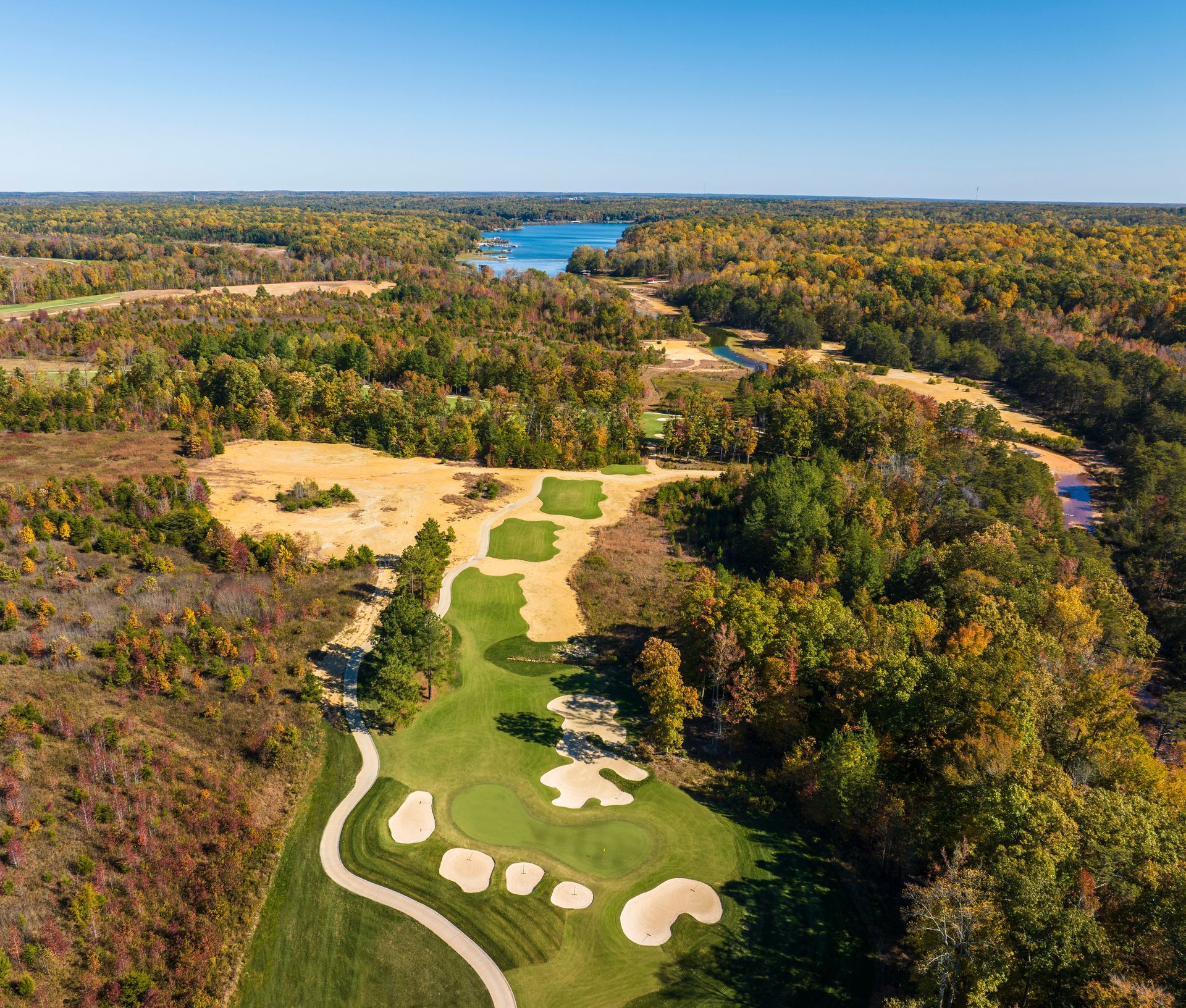
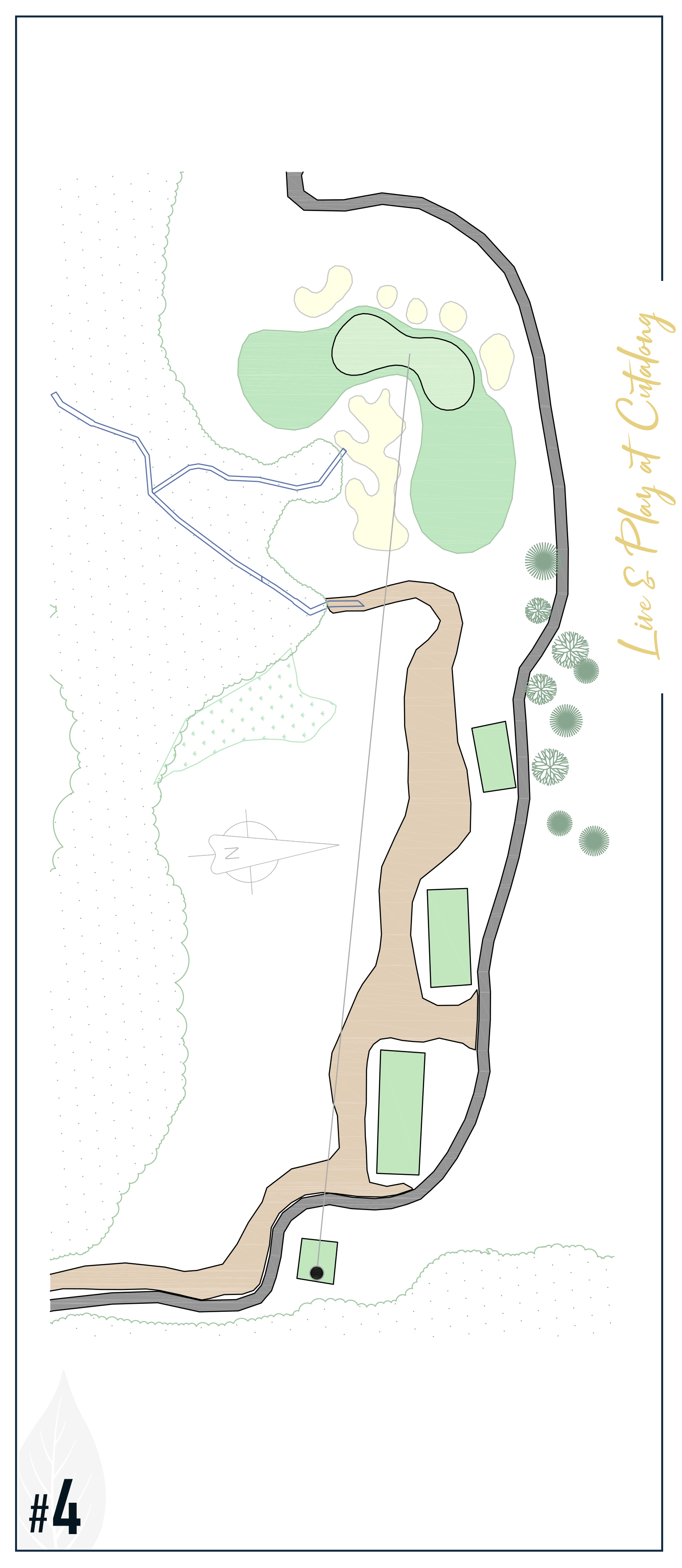
Hole NO.5
Five is the first hole that had to be created from dead flat terrain, and no architect reconfigured flat land better than the late, great Pete Dye. So this alternate-fairway short par-4 is Tom and Ron’s salute to Pete and incorporates such Dye characteristics as a long, winding waste bunker that doubles as a cart path, a wooden-post bulkhead edging the wetlands hazard on the left, pot bunkers lined with Dye trademark railroad ties and a two-pronged green similar to the boomerang ones that Pete built at courses like Crooked Stick in Indiana and Harbour Town in South Carolina. The flag location will likely dictate which avenue will be taken on any given day. After you putt out, check the area behind the green, which has been selectively cleared to provide a pleasant glimpse of Contrary Creek.
Hole NO.6
Six features what may be the most magnificent fairway on the course, a rumpled blanket of turf that dips and rolls and rises uphill to a high point that’s the ideal landing area. Except for removal of trees, almost nothing was done to these landforms. From the top of the hill, the second shot is probably the toughest on the course for average golfers, a forced carry over a deep stream ravine to a distant and deceptive green, based on those found at Donald Ross’s masterpiece Pinehurst No. 2. The original concept was to call this hole a par 4-and-a-half; anyone using nine strokes in playing the hole twice would be playing the sixth in par figures. On the official scorecard, though, the sixth is listed as a regular par 4.
Hole NO.7
The uphill nature of the par-3 seventh originally brought to mind a H.S. Colt hole at Wentworth (West) in England, a pedestal surround by bunkers, but as construction commenced the seventh morphed more into something that an American architect like William S. Flynn or Perry Maxwell often produced, a shelf green with a perilous left edge countered by plenty of bailout to the right. During preliminary shaping, Gonzo carved out a pair of bunkers directly below the front edge of the green that uncannily resemble the famed Principal’s Nose at St. Andrews. Thus, the seventh is now Cutalong’s Principal’s Nose par 3.
Hole NO.8
As with any gambling par 5, the eighth must be studied in reverse. The unique V-shaped putting surface was Whitten’s suggestion, based on Redan fortresses once found at many Civil War battlefields in the South. (Golf has many Redan greens around the world, all of which emulate only one half of a true V-shaped Redan.) Access to Cutalong’s true Redan green is over a creek and through either of two openings in the tree-line. The left-hand slot is definitely the route for those attempting to reach the green in two. The right-hand slot, farther down the fairway, is the best option when the flag is on the lower right portion of the V. The front edge of the front bunker is a spread of posts, our version of a Civil War defensive “Stockade Redan”. To take advantage of the left-hand slot, position off the tee is critical. While much of the fairway slopes noticeably from right to left, the landing area has been flattened to reward those who drive it long and straight.
-
City skyline
Photo By: John DoeButton
Hole NO.9
The long uphill par-4 ninth is totally bunkerless, just one of two such holes at Cutalong. Instead, a series of natural rock outcroppings seem like potential hazards, although in truth they are permanent obstructions that afford free drops. The fairway rolls uphill from tee to green, constantly kicking from right to left, and the green at the end of the rise is a mirror image of Alistair Mackenzie’s 14th green at Augusta National with its distinctive plateaus and ridges that sometimes pose putts that can break ninety degrees.
Hole NO. 10
The par-4 10th revisits the concept of the Redan as found on many golf courses, but here the entire hole is the Redan, with a fairway that cants and slants just as much as the green, which drops from front left to back right. The hole is intended to be reachable from the tee, although big hitters will find a ball carrying all the way onto the green will not likely stay there. The smart play is to utilize the fairway contours and aim to the high side left of the green, allowing gravity and firm conditions to propel the tee shot onto the putting surface.
-
City skyline
Photo By: John DoeButton
Hole NO.11
The par-5 11th is shaped like a fishhook, and for most it will play as a true three-shot hole. A diagonal stream bisecting the fairway beyond the crest will force bigger hitters to throttle back. Even with a good, long, well-placed drive, tall trees up the right side will require a controlled fade to reach the putting surface in two. The green, perched halfway up a slope, is similar to the seventh at Burnham & Barrow Golf Club in Somerset, England, attributed to Colt’s partner C.H. Alison, who remodeled the course over 70 years ago.
-
City skyline
Photo By: John DoeButton
-
City skyline
Photo By: John DoeButton
Hole NO.12
Besides the Redan, another popular template green is the Biarritz, a C.B. MacDonald invention featuring a long rectangular green bisected by a wide, deep depression that creates front and back plateaus. Cutalong’s Biarritz differs from most because the green is set at an angle to the line of play, especially from the back tee, where the tee shot through an opening in a thick line of trees is to the wide, shallow portion of the green, and fronted by two deep bunkers. From the remaining tees, the shot is more into the length of the green, and shots can be more easily rolled through the trench and onto the back section when the pin is back.
Hole NO.13
Thirteen is yet another hole that required almost no earthmoving. Off the tees, the fairway slopes distinctly left to right, and a two target bunkers on the high side provides the direct line that is meant to be carried in order to keep the ball on the fairway. The approach must carry a slope, now graced by a necklace of three bunkers, to a plateau where the low-profile green is barely visible. There are no bunkers around the green, but the ground to the right drops off abruptly. The putting surface is complex, with a spine in its middle. Many putts could be missed here.
Hole NO.14
The par-5 14th is absolutely the most unique hole at Cutalong, and one of the most unique in all of golf. Incorporating elements of Coore & Crenshaw’s second hole at Talking Stick North in Arizona, the eighth fairway at Prairie Dunes in Kansas and the Road Hole at St. Andrews, Scotland, there are alternate ways to play this hole, depending upon the tee used. From the back tees, the play is up the left side, through a gap in the trees and over cross bunkers to hidden fairway. There’s ample room to the right, but anything missed left will drop into the 10-foot deep railroad cut, another remnant of that initially encountered on thirds hole. It runs parallel to the fairway for 300 yards has been converted into a long strip bunker of tailings and random railroad ties. The green, a mirror image of the 17th at St. Andrews, complete with Road Hole pot bunker, lies dead ahead, but the fairway squeezes considerably as one approaches the green. From the forward tees, drives must be played up the right-hand fairway, as trees and rough block access to the left one, and the closer one plays their second shot towards the left fairway edge (bringing the railroad bunker into play), the better the angle into the green. There’s also a nasty mineshaft in the right hand rough short of the green, a tribute to the real mineshafts that once peppered the hillsides of this hole.
Hole NO.15
The relatively short par 4 15th utilizes two distinct strategies to attack the green. A safe shot down the generous left side of the fairway will leave the player with an open look into the green, but the shot will flirt with the deep bunker at the front left of the putting surface. A big drive over the fairway bunkers to the right (traps artfully shaped to honor the artistry of famed architect Alister MacKenzie) will leave a very short, half-blind pitch over a knob containing another bunker. The green sits in a classic punchbowl landform, like that found at the 16th at National Golf Links on Long Island. A shot even over the very right edge of the front bunker will still end up on the green, as the curved slope embracing the right side of the putting surface is mowed short and tight.
Hole NO.16
The other bunkerless hole at Cutalong is the par-4 16th, which is good to know as the tee shot from the back sets of tees is blind over a sideslope into a hidden but very generous landing area. The green sits atop a rise beyond a natural draw, and thus requires a full carry in the air to reach the putting surface, which is large and receptive. The distinctive mounding on the front and left side of the green are reminiscent of mining spoils found elsewhere on the property. Beyond the green is a steep slope that poses a difficult recovery pitch down the slope of the green.
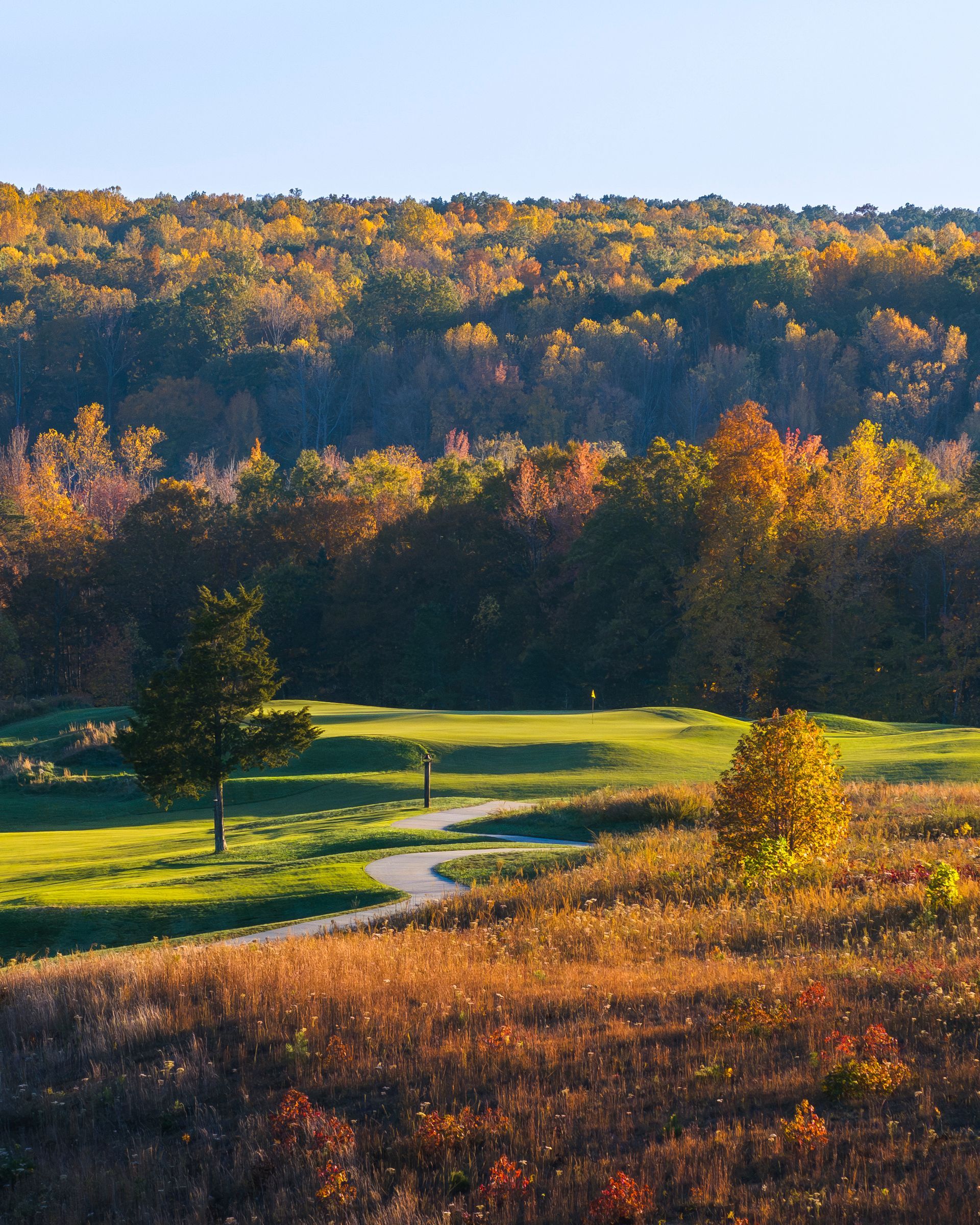
Hole NO.17
One of Tom’s favorite par 3s in golf is Alister MacKenzie’s Gibraltar at Moortown in Leeds, England, with its unusual positioning of bunkers elevated above the green on the right and well below the green on the left, a configuration that has subconsciously affected many a golf swing. Tom has used Gibraltar as a pattern for a par 3 before, but Cutalong’s version is as true to the scale of the original as can be found on this side of the Atlantic. His only concession is the absence of the two bunkers behind the green. This Gibraltar has trouble enough without them.
Hole NO.18
From the day Tom first walked the property, he was captivated by the natural valley that rises gently to the northwest. It reminded him of the 18th hole at William S. Flynn’s Shinnecock Hills on Long Island, and early in the planning, Tom determined this would be Cutalong’s 18th. As Shinnecock is renowned for its prolific bunkering, this par-4 is the most heavily-bunkered hole on the course. Among the dozen bunkers found on this hole are a target bunker just left center of the target line and a legion of five up the left side. The diagonal green is one of the smallest and most exacting on the course, deliberately so, as long hitters will be approaching it with a mid-iron and short hitters will be playing their third into it with a wedge. Cutalong’s 18th is a superb conclusion to a collection of unique and challenging golf holes.












